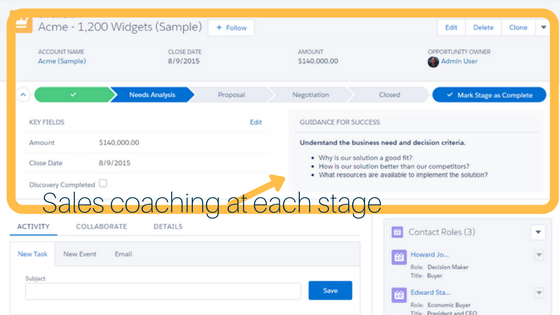6 Effective Tips for Leading Sales Teams With Salesforce
Leading sales teams can be a very challenging task. Luckily, Salesforce has functionalities that make the process of managing and motivating sales teams easier and more effective. Here are six […]
Leading sales teams can be a very challenging task. Luckily, Salesforce has functionalities that make the process of managing and motivating sales teams easier and more effective. Here are six ways sales team managers get the most out of Salesforce.
1. Assigning Ownership of Metrics
The benefits of Salesforce implementation are vast, but one of its most powerful features is its ability to track metrics. Too often, organizations don’t leverage the power of that data to drive future and repeat sales.
Team leaders can make sure their teams are making the most of sales data by running every sales meeting from Salesforce dashboards. When sales teams continue to use spreadsheets to manage their team and their metrics then it results in inaccurate or subjective data. Successful sales teams leverage Salesforce reporting to build custom reporting and insightful dashboards that is populated with data that each sales person enters.
2. Building Culture
The culture of a sales team can drastically impact the team’s performance. Salesforce can help create a culture driven by accountability and metrics that motivate team members to continue to achieve more. Its astounding how many sales teams are not held accountable to anything. When there isn’t accountability then the culture is going to lack the desire to perform to a sales plan and rather just react to whatever opportunity or issue is in front of them. But when there is a culture of accountability to a sales plan that ultimately gets reviewed in Salesforce then there is a dramatic improvement in how sales people perform to their sales plan – because they have to use Salesforce to do their jobs and perform against their sales plans.
3. Growing a Team More Easily
It can take a significant amount of time for a salesperson to begin generating revenue. Salesforce can help expedite a new team member’s ramp-up time (and increase their speed to profitability) by empowering sales managers to track their progress. Salesforce allows management to track individual pipelines, and Sales Path lets management coach team members and share important information directly from Salesforce, making it easier for a salesperson to jump start their activity in a new role.
4. Integrating Sales and Marketing
Salesforce helps organizations put the power of marketing directly in the hands of their sales team by integrating Salesforce Engage into Salesforce. Salesforce Engage lets your sales people create marketing ready emails and drip campaigns from Salesforce. This results in sales people improve their nurturing and engagement with a customer or prospect.
The program also shows the customer journey across all marketing and sales efforts, providing a comprehensive view that helps your sales team as they push leads down the funnel. This gives insights to sales people as it relates to which of their clients or prospects are visiting their website, opening their emails and more.
5. Tracking Activity vs. Results to Drive Performance
Understanding the path to a sale and ROI on various sales activities is critical to optimizing a sales process. Salesforce lets users pull activity reporting and learn what kind of activity is necessary to reach certain conversions.
Knowing the number of phone calls it takes for a prospect to sign up for a demo can help team leaders set goals, identify top performers (as well as learn from their process), and understand who might be struggling to convert prospects — all of which can help improve the sales process.
6. Empowering Continuity in the Sales Process
Though it’s not ideal, team members will inevitably get sick or transition into other jobs. With Salesforce, the process of transferring that work is seamless. Salesforce allows teams to track every prospect and client interaction, which means one team member can easily pick up where the former left off.
Team leaders who want to most effectively lead their sales teams can use these tips and other Salesforce functionalities and integrations to better manage employees, keep sales people focused on the most important activities, and quantify the best path to success. To learn more, contact Galvin Technologies today to see how you can more effectively lead your sales team.
Also published on Medium.
Share article
— Related Articles —
— Also on Galvin Tech —
Also published on Medium.









